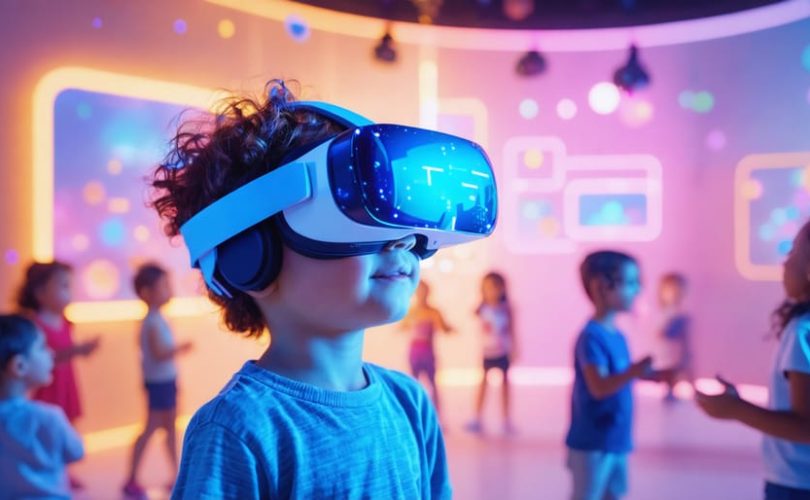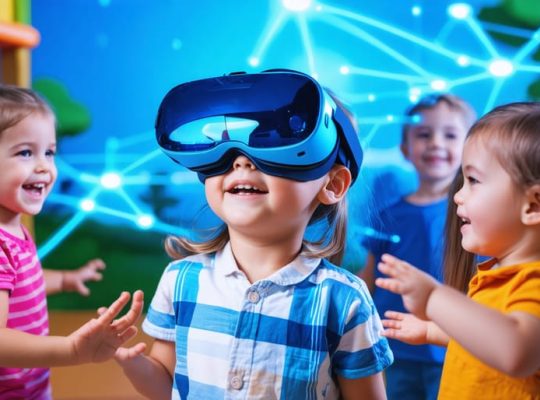Virtual reality is revolutionizing how we connect, learn, and interact in the digital age, offering unprecedented opportunities for social development and communication. As social media platforms increasingly embrace VR technology, children and adults alike are discovering new ways to build meaningful relationships and practice social skills in safe, controlled environments. These immersive digital learning tools are particularly transformative for children who struggle with traditional social interactions, providing them with structured, anxiety-free spaces to develop confidence and competence.
Research shows that VR-enhanced social media platforms can help children practice essential social skills like maintaining eye contact, reading facial expressions, and navigating group conversations—all while remaining in a comfortable, familiar environment. For parents and educators concerned about screen time and online safety, VR social applications offer a unique middle ground: they combine the engagement of digital interaction with the developmental benefits of face-to-face communication.
As we stand at the intersection of social media evolution and educational technology, understanding how to harness VR’s potential while maintaining appropriate boundaries becomes crucial for supporting our children’s social development in an increasingly digital world.
How VR Social Platforms Support Child Development
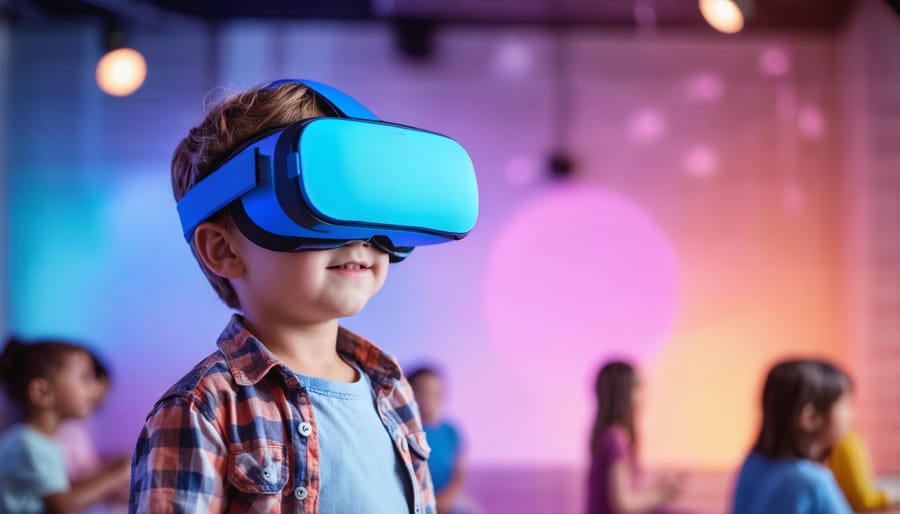
Safe Social Practice Environments
Virtual reality offers safe, controlled spaces where children can practice social interactions without the anxiety often associated with real-world encounters. Like AI-assisted learning environments, these virtual spaces can be customized to match each child’s comfort level and developmental needs.
Emily Chen, a child psychologist specializing in social anxiety, shares, “In these virtual environments, children can practice everything from maintaining eye contact to handling challenging conversations with peers. If they make mistakes, there are no real-world consequences, which helps build confidence gradually.”
These practice environments often feature friendly avatar companions and scenarios that mirror common social situations, such as joining a playground game or speaking up in class. Parents and therapists can observe these interactions and provide immediate guidance, helping children develop stronger social skills at their own pace.
The beauty of these virtual spaces lies in their adaptability. Settings can be adjusted to become more challenging as children grow more confident, creating a natural progression toward real-world social engagement. This stepped approach helps children build resilience while feeling supported and safe.
Real-time Social Feedback
Virtual reality’s most powerful feature in social development is its ability to provide immediate, natural feedback during interactions. When children engage in VR social scenarios, they can see and feel how their actions affect others in real-time, much like a digital mirror for social skills.
For example, when a child maintains good eye contact with a virtual character, they might receive subtle positive cues like a friendly smile or encouraging nod. If they speak too loudly or stand too close, the virtual character’s body language might show discomfort, helping children understand social boundaries naturally.
Parents and therapists often report that this immediate feedback helps children grasp social concepts more quickly than traditional teaching methods. As one child development expert notes, “It’s like having a gentle coach right there in the moment, helping kids understand the impact of their actions without the anxiety of real-world consequences.”
The technology also allows for repetition and practice in a safe environment. Children can try different approaches to social situations, see the outcomes, and gradually build confidence in their abilities. This immediate cause-and-effect relationship makes learning social skills more tangible and engaging for young minds.
Benefits for Children with Social Challenges
Anxiety Reduction Through Virtual Exposure
Virtual reality offers a groundbreaking approach to helping children overcome social anxiety through controlled, gradual exposure to challenging situations. Think of it as a gentle bridge between complete avoidance and real-world interactions, allowing children to build confidence at their own pace.
Dr. Sarah Chen, a child psychologist specializing in anxiety disorders, explains, “VR creates a safe space where children can practice social scenarios without the fear of real-world consequences. They can try, make mistakes, and learn from them without feeling overwhelmed.”
The process typically starts with simple virtual interactions, such as ordering food in a digital café or raising their hand in a virtual classroom. As children become more comfortable, the scenarios can gradually increase in complexity, perhaps advancing to giving presentations or joining group activities in the virtual space.
Nine-year-old Alex’s experience illustrates this approach’s effectiveness. Initially struggling with severe social anxiety, Alex began using VR therapy sessions to practice playground interactions. “After six weeks, we saw remarkable progress,” his mother shares. “He started initiating conversations with classmates at school, something he’d never done before.”
The beauty of VR-based exposure therapy lies in its customization potential. Therapists can adjust the intensity of social situations, control environmental factors, and provide immediate support when needed. This level of control helps ensure that children remain within their comfort zone while gradually pushing their boundaries.
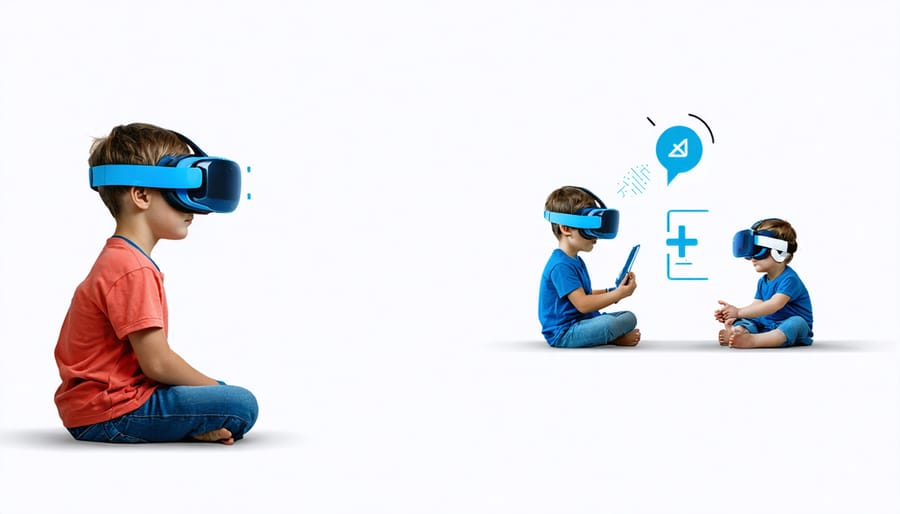
Customized Learning Experiences
Virtual reality in social media is revolutionizing how children learn and develop social skills through personalized learning technology that adapts to each child’s unique needs. Sarah Martinez, a child development specialist, shares how her students have benefited from customized VR scenarios: “We’ve seen remarkable progress in children who previously struggled with traditional social skill development methods.”
These tailored experiences consider factors like a child’s age, communication style, and specific challenges. For instance, a child who finds it difficult to maintain eye contact might start with gentle, low-pressure virtual interactions that gradually become more complex as their confidence grows. The system tracks progress and adjusts difficulty levels accordingly, ensuring each child moves at their own pace.
Parents like Emma Thompson have noticed significant improvements in their children’s social confidence. “My son used to be overwhelmed in group settings, but after practicing in virtual environments that matched his comfort level, he’s much more at ease in real-world situations,” she explains.
The customization extends to various scenarios, from classroom interactions to playground situations, allowing children to practice specific social skills they find challenging. This personalized approach helps build confidence gradually while providing a safe space for making mistakes and learning from them.
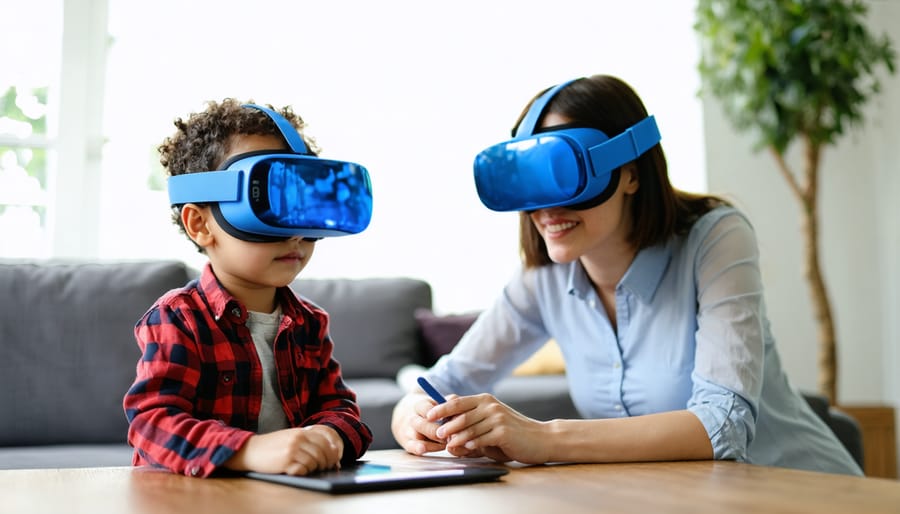
Parent and Professional Guidance
Monitoring and Support Strategies
When introducing children to virtual reality social media platforms, active monitoring and support are essential. Create a dedicated space where you can observe their interactions while respecting their independence. Set clear time limits for VR sessions, typically 15-20 minutes for younger children and up to 30 minutes for teens, with regular breaks to prevent eye strain and maintain physical activity.
Establish open communication about online experiences, encouraging children to share both positive interactions and any concerns they encounter. Watch for signs of excessive use, such as decreased interest in real-world activities or changes in sleep patterns. Consider using built-in parental controls and privacy settings to create age-appropriate boundaries.
Partner with teachers or therapists who use VR in educational settings to align home and professional support strategies. Regular check-ins about content and interactions help ensure the technology remains a positive tool for social development. Remember to model healthy technology use yourself and create opportunities for both virtual and real-world social connections.
For children with special needs, work with healthcare providers to develop customized monitoring plans that support their unique social learning goals while maintaining their safety and comfort in virtual environments.
Integration with Traditional Social Learning
While virtual reality offers exciting new possibilities for social interaction, it’s essential to view it as a complement to, rather than a replacement for, traditional social experiences. Many families find success by incorporating VR social activities alongside real-world practice, creating a balanced approach to social skill development. For example, a child might practice greeting new friends in a virtual environment before trying these skills at the park.
Parents and educators can use VR as one of many cognitive development tools to support social growth. Consider scheduling “mixed practice sessions” where children alternate between virtual and real-world social interactions. This approach helps transfer skills learned in VR to everyday situations while maintaining authentic human connections.
Dr. Sarah Chen, a child development specialist, suggests starting with 15-minute VR social sessions followed by guided real-world practice. “The key is to use VR as a stepping stone,” she explains. “When children feel confident in virtual environments, they often find it easier to apply these skills in real-life situations.”
Remember to celebrate progress in both virtual and real-world settings, acknowledging that each environment offers unique opportunities for growth and learning.
Safety and Best Practices
As parents and educators, it’s crucial to establish safe boundaries when introducing children to virtual reality social platforms. Start by setting clear time limits – experts recommend no more than 30 minutes per session for children under 13, with regular breaks to prevent eye strain and motion sickness. Always supervise young users during their VR sessions, especially during initial experiences.
Create a comfortable and clear physical space for VR activities. Remove obstacles and ensure there’s at least a 6-foot square area for safe movement. Consider placing a soft mat on the floor to help children stay oriented within their safe zone.
Privacy settings are paramount in social VR environments. Work with your child to set up strong privacy controls, including friend lists and communication restrictions. Teach them about not sharing personal information and how to recognize and report inappropriate behavior.
Monitor for physical and emotional wellness signs. Watch for symptoms like dizziness, headaches, or eye discomfort, which might indicate the need to adjust usage. Pay attention to changes in mood or behavior after VR sessions.
Dr. Sarah Chen, a child development specialist, suggests: “Think of VR social spaces like a playground – children need guidance, boundaries, and occasional check-ins to ensure they’re having a positive experience.”
Consider using family-friendly VR platforms specifically designed for children, which often have built-in safety features and moderated environments. Many of these platforms allow parent accounts to monitor activity and adjust settings remotely.
Remember to balance VR social interactions with real-world connections. Use VR as a complement to, not a replacement for, traditional social experiences.
Virtual reality in social media represents a transformative frontier in how we connect, learn, and grow together. As we’ve seen, this technology offers unique opportunities for children to develop social skills in a safe, controlled environment while engaging with others in meaningful ways. Parents and educators are increasingly recognizing VR’s potential to help children who struggle with traditional social interactions to build confidence and practice essential communication skills.
Looking ahead, we can expect to see more specialized VR applications designed specifically for social skills development, with features tailored to different age groups and specific learning needs. The integration of artificial intelligence and advanced feedback systems will likely make these experiences even more personalized and effective.
However, success in this area will depend on maintaining a balanced approach – using VR as a complement to, rather than a replacement for, real-world interactions. With proper guidance and thoughtful implementation, virtual reality can serve as a powerful tool in our collective effort to support children’s social development, helping them build the confidence and skills they need to thrive in both digital and physical spaces.
Remember, the goal isn’t to create a virtual substitute for human connection, but rather to provide additional pathways for children to develop and practice the social skills they’ll need throughout their lives.

